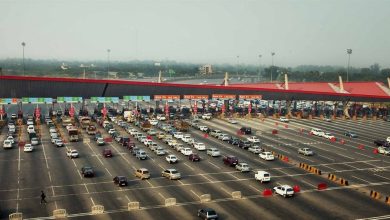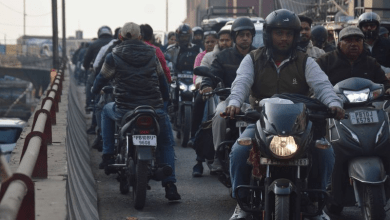Traffic Update: Right Turns Blocked at Rahate Colony and Kriplani Squares During Peak Hours

In a bid to tackle the rising traffic congestion on Wardha Road, the City Traffic Police have announced new traffic arrangements at Rahate Colony Square and Kriplani Square. Starting Monday, right turns at both squares will be blocked from 5:30 PM to 8:30 PM, significantly impacting daily commuters traveling between Nagpur and Wardha.
Why This New Traffic Arrangement?
Wardha Road is one of Nagpur’s busiest routes, and the evening hours witness a massive surge in vehicles. According to DCP Traffic Archit Chandak, there has been a consistent rise in traffic moving between Nagpur and Wardha, especially during peak hours. As vehicles from the Shaheed Govari Flyover approach Rahate Colony and Kriplani Squares, the traffic jams become more severe.
So, what’s the solution? To reduce bottlenecks and ensure smoother traffic flow, the authorities have decided to block right turns at these intersections on an experimental basis.
Key Details of the Traffic Diversions
Blocking right turns at both Rahate Colony and Kriplani Squares might seem inconvenient initially, but the goal is to alleviate traffic jams. The changes will be in place from September 23 to 28, with the possibility of continuation depending on the results.
Here’s a breakdown of the new arrangements:
1. No Right Turns from Morris College T-point to Ajni Square
Vehicles traveling from Morris College T-point towards Ajni Square will not be allowed to take a right turn at Rahate Colony Square or Kriplani Square. Instead, they will proceed straight to their destinations, bypassing these intersections.
2. Traffic Movement from Ajni Square to Morris College T-point
Similarly, vehicles moving from Ajni Square towards Morris College T-point will have to avoid turning right at Kriplani or Rahate Colony Square.
3. Diversion for Vehicles from Mata Kacheri
For those driving from Mata Kacheri towards Kriplani Square, the route will change. Instead of turning right at Kriplani Square, these vehicles will be diverted at Mata Kacheri. They will need to proceed to NEERI T-point, take a left turn towards Ajni Square, and then make a U-turn towards Manish Nagar Flyover.
4. U-Turns for Vehicles from Ajni Flyover and Congress Nagar
If you’re traveling from Ajni Flyover or Congress Nagar T-point, the new arrangement requires you to make U-turns at Kriplani Square and Ajni Square.
5. Blinker Mode for Traffic Signals
Another crucial part of this new strategy is setting the traffic signals between Rahate Colony Square and Ajni Square to “blinker mode” during peak hours. This change aims to speed up traffic flow through the area, minimizing the stop-and-go pattern that often leads to congestion.
Why This Plan Matters?
For residents and commuters in Nagpur, this traffic update is more than just a minor inconvenience. It’s part of a larger effort to streamline traffic and reduce the frustration of daily gridlocks. As the city continues to grow, so does its traffic, and measures like these are becoming essential.
Authorities have emphasized that this is an experimental change. The period from September 23 to 28 will be a testing phase, and based on the results, the traffic department may decide to make this arrangement permanent. Additional traffic personnel will also be deployed during these hours to ensure a smooth transition.
How Will This Impact Daily Commuters?
For those who frequently use Wardha Road during peak hours, this change might mean adjusting routes or planning a little extra time for their commute. However, the City Traffic Police believe that these diversions will ultimately make the traffic flow more efficient and reduce the average time spent in traffic.
It’s crucial to note that while the inconvenience might be frustrating at first, the long-term benefits could lead to a smoother commute for everyone.
Benefits of the New Traffic Arrangement
- Reduced Congestion: By blocking right turns and allowing vehicles to flow through the intersections without stopping, congestion is expected to reduce.
- Safer Traffic Conditions: The deployment of additional traffic police ensures safer driving conditions.
- Quicker Commutes: Once the initial adjustment phase passes, daily commutes are expected to become faster and more predictable.
- Experimental Phase: Since this is a trial period, the authorities are keen on receiving feedback from commuters and adjusting the plan accordingly.
What Commuters Should Know
If you frequently travel through Rahate Colony Square or Kriplani Square, it’s important to stay updated on these changes. Here are a few quick tips to help you navigate the new system:
- Plan Ahead: Consider alternate routes or factor in extra time for your commute, especially during the experimental phase.
- Stay Alert for U-turns: Remember that U-turns will now play a significant role in your route, so keep an eye on the new traffic flow.
- Look Out for Blinker Mode: The traffic lights will switch to blinker mode, meaning you’ll need to be extra cautious and aware of other drivers’ movements.
Additional Resources for Drivers
Nagpur residents can always check for live traffic updates using the Nagpur Traffic Police’s online portal or social media channels. Authorities will regularly update citizens on any further changes to the traffic plan, ensuring minimal disruption.
A New Chapter in Traffic Management
This traffic update marks another chapter in the evolving landscape of Nagpur’s urban development. As the city continues to expand, managing the flow of vehicles becomes increasingly crucial. The Rahate Colony Square and Kriplani Square experiment is a necessary step in addressing the challenges of urban congestion.
By observing how these changes impact traffic over the next few days, authorities will have a clearer idea of what steps to take next. Whether these diversions become permanent or evolve into something else, one thing is clear: traffic management in Nagpur is moving towards a more efficient future.
The decision to block right turns at Rahate Colony Square and Kriplani Square during peak hours is a strategic move to tackle traffic congestion on Wardha Road. While the adjustment phase might cause some initial confusion, the long-term benefits for daily commuters are evident. As this is an experimental phase, the City Traffic Police will continue to monitor and tweak the arrangement based on the feedback from drivers and the flow of traffic.
1. What are the peak hours for the new traffic arrangement?
The peak hours during which right turns will be blocked are from 5:30 PM to 8:30 PM.
2. When does the trial period for this new arrangement begin?
The trial period will run from September 23 to 28.
3. Will there be additional traffic police during the experimental phase?
Yes, additional traffic personnel will be deployed to help manage the new traffic flow.
4. Can vehicles still make U-turns at Rahate Colony Square?
No, vehicles will not be allowed to make right turns at Rahate Colony Square or Kriplani Square, but they can make U-turns at designated points.
5. How will the blinker mode help traffic?
Blinker mode at traffic signals will allow vehicles to flow more smoothly through intersections without the usual stop-and-go traffic pattern.









